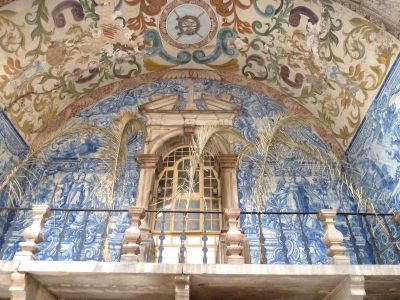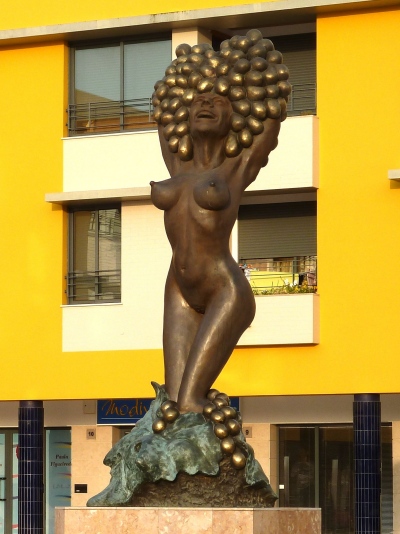The
next morning we drove across the river Tejo to the large provincial
capital
of Santarem set upon a hill. It was too busy to park in the centre
where we passed a large tiled market hall so we continued west through
the suburbs and eventually found the road to Rio Major and
followed the tourist signs to the Salinas where salt is still harvested
by evaporation. We were able to walk around the salt pans and the
distinctive traditional wooden
buildings made from olive tree trunks, some converted to shops, a cafe
and a small museum.

Saltworks traditional building
From there we
drove into the forested hills of the Sierra dos
Candeeiros
climbing up to the tiny village of Chãos where an overnight stop was
listed at a picnic spot. We decided not to stay at such a remote
place and whilst parked there for lunch we discovered that
our water tank was leaking
due to a split, so a change of plan was needed and we drove
back to Rio Major and then on to the coast at Peniche hoping to buy a
water container. Once there we parked by the harbour with a few other
motorhomes for a walk around the
old town, and with the help of a friendly shop keeper who spoke just a
little French we found a hardware shop to buy a 20 litre water
container for €8. (At least we learnt that the Portuguese
word
for jerrycan is jerrycan). When we returned to the van we discovered
the cap was too narrow to fit the submersible pump! We
drove round the headland and stopped at the Praia Peniche campsite
where they had low cost motorhome pitches. It wasn't in a very
attractive part of the town and even the site's
pedestrian gate needed a security card. As the weather was rough
we only went for a quick stroll along the cliffs.
 Ó
Óbidos
- decorated gateway
The next morning we drove inland to old walled town of
Óbidos,
a
major tourist attraction, and were directed to the private
motorhome aire which cost €2.50 for the day (€2 extra to use the
service point). The town was worth a walk around with narrow streets
within the old walls which had very uneven and unguarded walkways
around the parapets. There was the usual mix of gift shops and
expensive art
and craft galleries catering for the many visitors along the
maze of cobbled streets. From there we continued to Caldas da
Rainha, a busy spa town, then back to the coast road and along to
Nazaré. Motorhomes are banned from all the carparks and the aire was
full so we headed
for the Orbitur
campsite a couple of kilometres inland where there were a few
level
pitches on the soft sandy soil among pine trees and there
was free wifi in the "Conviviality" room. Nazaré is famous for its
fishermen's wives who wear seven skirts and stand by the roadside with
signs offering
rooms to let. Many are colourfully dressed for the benefit of the
tourists but we did see some genuine old ladies with the traditional
tartan style skirts at the market hall. We
drove into the town centre the next morning in warm
sunshine and parked
at an empty carpark where a weekly market is held. We
discovered
the "No motorhomes" sign thrown on the ground when we returned but
luckily
avoided a parking fine. After walking
along the promenade alongside the large sandy beach
we took
the funicular railway up to the old town of S
ítio. There
were fine
coastal views from the overhanging cliffs and we walked around the
church square where there
were stalls
manned by colourfully dressed ladies selling dried fruits and
nuts to the many coach parties.

Fisherman's wife
Returning to the van we drove inland again with a diversion along an
extremely busy main road to the outskirts of Leiria where
we found a small motorhome dealer and managed to buy
a wheeled water tank (which cost €90 but needs must!!). We
reached
Batalha where there is an aire behind the impressive abbey and wandered
around the building glad of some shade on
an extremely hot afternoon, and then drove on through small
industrial towns to the large Catholic shrine at Fátima where we stayed
overnight with several motorhomes in Car Park No4. There were a few
pilgrims around in the evening including two devout ladies approaching
the basilica on their knees and looking in great pain.

Conímbriga Roman mosaic floor
The next morning we set off north across the hills to Conímbriga, a
large Roman site with well preserved mosaic floors
and baths with a complex underfloor heating system. After
looking around the buildings and the museum full of everyday artefacts,
we continued our journey bypassing the city of Coimbra and stopped at a
small municipal campsite at Penacova where the next morning we
discovered a new free aire in the town centre. A short drive took us to
the forested Mata Nacional do Buçaco, and after paying a €7 toll drove
through the dark woods to the old convent and ornate 19th Century
palace, now an
exclusive hotel. From the parking area there is a maze of paths
passing Calvary shrines and waterfalls to the top of the hill for a
great view.

Buçaco convent entrance
To the north of the forest is the small spa town of Luso but we headed
back to the coast at Mira then along flat coastal plain where virtually
every house had sacks of potatoes and onions for sale, to the
small resort of Vagueira and another Orbitur campsite. We tried to use
the site's new motorhome service point before leaving the next morning
but they had omitted to install a waste water drain! As it was a sunny
and warm day we drove just a few kilometres alongside a lagoon to Costa
Nova where we parked on a track with some other vans by the beach and
dunes
at the southern edge of the attractive seaside town with its
uniquely striped houses. We spent the day and night parked here
although we came across a larger aire behind the town centre which was
full, mostly with old cars. As it was the weekend the town was busy
with trippers.


